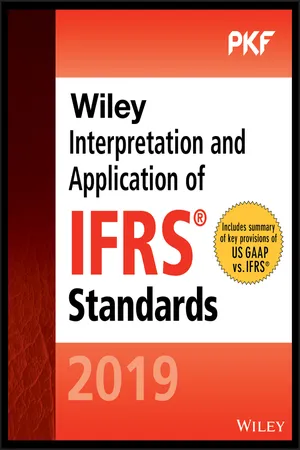
- English
- ePUB (mobile friendly)
- Available on iOS & Android
About this book
The 2019 reference for the interpretation and application of the latest international standards
Wiley IFRS ® Standards 2019 is a revised and comprehensive resource that includes the information needed to interpret and apply the most recent International Financial Reporting Standards (IFRS ® ) as outlined by the International Accounting Standards Board (IASB).
This accessible resource contains a wide range of practical examples as well as invaluable guidance on the expanding framework for unified financial reporting. The authors provide IFRIC interpretations and directions designed to ensure a clear understanding of the most recent standards.
The IFRS ® standards are ever evolving, therefore it is essential that professionals and students have the information needed to apply the standards correctly in real-world cases. Wiley IFRS ® Standards 2019 offers a complete, up-to-date reference that aids in the application of the latest international standards in a manner that is transparent, accountable and efficient. This edition includes IFRS 9 Financial Instruments; IFRS 15 Revenue from Contracts with Customers; IFRS 16 Leases and amendments issued and effective for annual periods beginning on or after 01 January 2018 and 01 January 2019 as issued by the IASB by 30 June 2018. This edition also includes some introductory guidance for IFRS 17 Insurance Contracts and incorporates the revised Conceptual Framework for Financial Reporting 2018.
This important guide is written by the people passionate about IFRS ® at PKF International. PKF International consists of over 400 offices, operating in 150 countries across five regions. PKF International specialises in providing high quality audit, accounting, tax, and business advisory solutions to international and domestic organisations around the globe.
PKF International is a global family of legally independent firms bound together by a shared commitment to quality, integrity and the creation of clarity in a complex regulatory environment.
PKF International is a member of the Forum of Firms – an organisation dedicated to consistent and high-quality standards of financial reporting and auditing practices worldwide. www.pkf.com.
PKF International Limited administers a family of legally independent firms and does not accept any responsibility or liability for the actions or inactions of any individual member or correspondent firm or firms. All rights reserved.
Frequently asked questions
- Essential is ideal for learners and professionals who enjoy exploring a wide range of subjects. Access the Essential Library with 800,000+ trusted titles and best-sellers across business, personal growth, and the humanities. Includes unlimited reading time and Standard Read Aloud voice.
- Complete: Perfect for advanced learners and researchers needing full, unrestricted access. Unlock 1.4M+ books across hundreds of subjects, including academic and specialized titles. The Complete Plan also includes advanced features like Premium Read Aloud and Research Assistant.
Please note we cannot support devices running on iOS 13 and Android 7 or earlier. Learn more about using the app.
Information
1
INTRODUCTION TO INTERNATIONAL FINANCIAL REPORTING STANDARDS
- Introduction
- Origins and Early History of the IASB
- The Current Structure
- Process of IFRS Standard Setting
- Convergence: The IASB and Financial Reporting in the US
- The IASB and Europe
- Appendix A: Current International Financial Reporting Standards (IAS/IFRS) and Interpretations (SIC/IFRIC)
- Appendix B: Projects Completed Since Previous Issue (July 2017 to June 2018)
- Appendix C: IFRS for SMEs
- Definition of SMEs
- IFRS for SMEs is a Complete, Self-Contained Set of Requirements
- Modifications of Full IFRS made in IFRS for SMEs
- Disclosure Requirements under IFRS for SMEs
- Maintenance of the IFRS for SMEs
- SME Implementation Group
- Implications of the IFRS for SMEs
- Application of the IFRS for SMEs
INTRODUCTION
Table of contents
- Cover
- Title Page
- Copyright
- About the Authors
- 1 Introduction to International Financial Reporting Standards
- 2 Conceptual Framework
- 3 Presentation of Financial Statements
- 4 Statement of Financial Position
- 5 Statements of Profit or Loss and Other Comprehensive Income, and Changes in Equity
- 6 Statement of Cash Flows
- 7 Accounting Policies, Changes in Accounting Estimates, and Errors
- 8 Inventories
- 9 Property, Plant and Equipment
- 10 Borrowing Costs
- 11 Intangible Assets
- 12 Investment Property
- 13 Impairment of Assets and Non-Current Assets Held for Sale
- 14 Consolidations, Joint Arrangements, Associates and Separate Financial Statements
- 15 Business Combinations
- 16 Shareholders’ Equity
- 17 Share-Based Payment
- 18 Current Liabilities, Provisions, Contingencies and Events After the Reporting Period
- 19 Employee Benefits
- 20 Revenue From Contracts with Customers
- 21 Government Grants
- 22 Leases
- 23 Foreign Currency
- 24 Financial Instruments
- 25 Fair Value
- 26 Income Taxes
- 27 Earnings Per Share
- 28 Operating Segments
- 29 Related Party Disclosures
- 30 Accounting and Reporting By Retirement Benefit Plans
- 31 Agriculture
- 32 Extractive Industries
- 33 Accounting for Insurance Contracts
- 34 Interim Financial Reporting
- 35 Hyperinflation
- 36 First-Time Adoption of International Financial Reporting Standards
- Index
- End User License Agreement